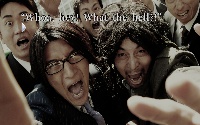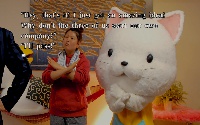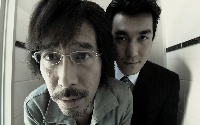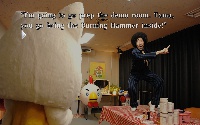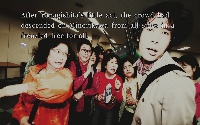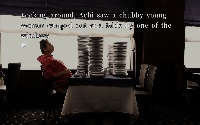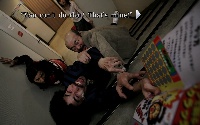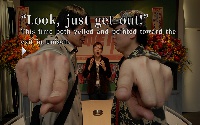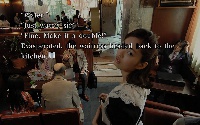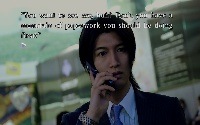428: Shibuya Scramble
Playtime: 19.8 Hours
Finished 25 February 2023.Finished the game all the way to the True Ending of the main storyline, which gave me the Black Bookmark on the savefile. I did get the Normal Ending first, so the True Ending was only after I redid some choices in the final chapter. I also got 48 out of 85 Bad endings; a lot of these are in the final chapter where the exact same sequence counts as different endings for each character. I don't have any interest doing any more of the bad endings, since those take too much time for me to be interested. There's also some pretty substantial side content, including 2 "full" side stories and 22 mini-stories exploring side characters met in the game outside of the context of the story - but I don't plan to do these either; my motivation is pretty much exhausted from the climax chapter.
This game is a Visual Novel like no other that I've played before - down to the fundamental way the "visual" aspects are implemented. It's a game that uses live-action photos and real actors for every frame like a photo album, as opposed to the illustrated CGs and character sprites of practically every other VN I've played thus far. This is a mid-evolution of the VN genre that ultimately sits somewhere between a typical VN and live-action television, which is very satisfyingly fresh. Unfortunately, since I can pretty much guarantee that the costs of this production were magnitudes greater than most other VNs, this will definltely ultimately remain in a class of its own - from the development standpoint, this project doesn't really allow for the cost-effectiveness of a small art/visual team, nor does it target a mainstream audience, who would generally be loath to play this kind of experience rather than simply watching a live-action game instead. I find that very disappointing, because I'd love to see more games of this style now that I've seen what this game was able to do.
To continue with more specific comments on the overall presentation of the game, I think the photo album approach is able to convey a wider variety of actions and emotions that would be possible in a VN, making this game seem far more dynamic; different situations in this game will use close-up photos to show tension, blur to emphasize action or to obscure parts of an image, adding a sense of pressure and vertigo, and clever framing and lighting to achieve the same. Additionally, sets of photos are sometimes arranged in a looping stop-motion style for comedic effect (usually when Yanagishita comes around...). In a few critical instances, short live-action clips are used to emphasize the gravity of a situation. An example would be the aftermath of the blue van car bomb, where Kano and Stanley squeeze through a crowd to rush to the scene. I thought each of the actors did a great job on their parts, portraying each of their personalities well through each still - this is especially important as this game has no voice acting at all. Sounds are limited to the well-fitting soundtrack, some sound effects (stuff like opening doors, using computers, gunshots - no "human" noises), and UI effects. While it took some getting used to, I think it was a good decision - seeing as the entire game takes place in Shibuya, it would feel horribly out of place to have clear speech for each actor without the din of the crowd alongside it (crowd noises for 20 hours would be absolutely horrible too).
Mechanically, the moment-to-moment gameplay of 428 is pretty simple to many other VNs other than the fact that it uses a fullscreen text display, rather than the separated textbox that is more common these days. The key lies in the way the story uses the 5 storylines as they run in parallel, and how the decisions made in one story impact the events of another. The full experience (which takes place across only one day in Shibuya, from around 10:00 AM to 20:00 PM) is divided into 1-hour blocks, which can be considered the "episodes" of the game. Each episode will have anywhere from 2 to 5 storylines to progress; every character will have a few crucial decisions to make in their part of the episode - these decisions can include dialogue, actions, or even internal thoughts, and will generally cause certain events to unfold in different way in both the current story and in other stories. When you reach a bad end with one character, most frequently the solution is to switch to another character's storyline and change a decision to change how certain events play out. This is the main "puzzle" mechanic of the game, but the implementation is pretty light on difficulty or obscurity - it usually doesn't take more than a couple of corrections per chaper to correct all the little problems before proceeding. Note that not all choices are actually meaningful - a decent number of them are there just for comedy or flavor text, which I find pretty fun.
There's also another mechanic, "jumping", which allows you to jump perspectives from one character to another at specific points in the story; this mechanic is liberally used in the game to enforce a degree of order in a playthrough, where certain stories will abruptly hit a "KEEP OUT" blockade which requires use of a Jump to pass. This is one of the more irritating aspects of the game in my opinion, since this jump mechanic isn't done very well. While some jumps are cool (jumping between perspectives of a conversation or a chase), lots of jump points are hidden behind completely irrelevant dialogue that just so happens to mention the name of a character, or even tips that are barely tangentially related. Sometimes these are also doubly hidden behind the other choice prompts, which makes them even harder to find - this ramps up a lot during the final chapter in particular, which made for a very tedious experience. There are some other outdated parts of the experience as well - text speed is at a very slow, controlled pace which cannot be sped up through options, and also cannot be skipped conveniently - this makes going for completion pretty awful (which is why I'm not interested in doing it). The interface is generally also a bit clunky to navigate as well, though it's nowhere near unusable. There are some other minor QoL features missing that I won't really bother going into here.
The plot of this game isn't really easy to fully describe in such a brief entry, but really boils down to a simple kidnapping case turning into something far more sinister, involving multiple conspiracies and several people targeting Hitomi for different reasons - for an antiviral drug, a donor heart of a rare blood type, or simply out of a sense of obligation (or so Achi says...). Kano's perspective in the story is mostly on tracing and apprehending a group of criminals who stole the random money from Hitomi at the very start of the case, before meeting up with Stanley, a CIA agent sent in to hunt down the mastermind of the plot. Meanwhile, Achi is a bystander who happens to get caught up in the case when saving Hitomi from a mysterious gunman, spending his time trying to help Hitomi look for her missing sister, all while evading multiple factions persuing them. I feel like his route spends a lot of time building a relationship between him and Hitomi, which is essentially the budding romance plot of the game; it does feel slightly strange though when thinking about the fact that the entire game takes place within a 10-hour span.
The other three characters are initially more detached from the kidnapping case, whose threads merge into the plot more clearly over the course of the game. Kenji Osawa's timeline is actually focused mostly on the development of a subplot involving a "Ua Virus", a pathogen capable of instigating a pandemic - sickness involves a less-than-12 hour incubation and almost certain death afterwards. I really liked the way his route focused more on this thread (which turns out to be very important), instead of having him just sitting around worrying about the case - it links him more closely to the actual story. Also, detective Kajiwara is pretty funny - so many photos frame him in a really creepy way but he's actually a super wholesome presence. Tama's storyline is the shortest, but has some of the most significant developments - I love the goofiness of Chiri and Yanagishita as they try to hawk this BS Burning Hammer product; a lot of the bad/alternate endings are hilarious, even if they technically wouldn't make sense from a continuity perspective. I feel like it leans a bit too heavily on the amnesia situation after the reveal of her identity (to the player), but otherwise I thought this was fine. Lastly, Minorikawa's route is probably the least relevant to the story - the only one that doesn't actually have any significant involvement in the kidnapping case by the end. With that in mind, though, I think his route adds a lot of very critical character to the game - all his dramatic pointing (and the absolute bro that is Kimizuka, the ultimate taxi driver) add a zany touch to the game, and a much-needed perspective of someone who's just trying to get stuff done in Shibuya while the other high-tension stuff is happening. I felt like he hit an interesting balance as an extremely intense, yet passionate and capable character who also happens to do a lot of weird shit; at the end of the day, he might be my favorite of the bunch - but not by much, since I like pretty much all the characters.
While I think a significant majority of the game is incredibly well put together, I have a few reservations about the ending that prevent me from consdering this game perfect to my own sensibilities and biases. I felt like this chapter really reared the ugly head of the jump mechanic - so many of them in this chapter were hidden by incredibly obtuse dialogue options. Additionally, while the subroutes of Tateno and Stanley are admittedly pretty great, the jump triggers to initiate those routes took me forever to find (needed to resort to a guide). This was especially annoying since I had already found multiple jump triggers for both of them, but did not find the specific one that allowed me to start their route - I probably wasted over half an hour watching the same dumb bomb ending because I couldn't find the one specific dialogue option to select. The jump mechanic should have focused more on story sections relevaant to a split instead of requiring annoying tip-hunting trips (with no easy skip/speed-up too). Secondly, while the twist involving Alphard's identity is also pretty cool in concept, it hits on a trope that I've always found insurmountably stupid - the secret agent 10-year-old. The idea that the CIA is hiring some random child for this kind of operation is laughable dry comedy at best and pathetically awful on a bad day - noting that Alphard has been on the loose for years means that she would have been making and deploying bombs in terrorist attacks at single-digit age, which is a conspiracy at the level of Ahmed's clock bomb. This did legitimately ruin the game for me a little bit; they couldn't have found someone who at least looked to be in her late teens to play "Canaan"? Also, as a last note - the true ending's post-credits "stinger" is also really stupid; not only did the all the CIA agents not care about Alphard staying back, but the real Canaan did a peak idiot move - if you're there for revenge, just shoot Alphard... why was she trying to walk up to her? LOL. I definitely would have preferred for the game to have a domestic mastermind instead of lumping the Middle East randomly into the equation again; with the final and true revelations, it turns out this game wasn't particularly heavily tied to Shibuya, other than it being a convenient and recognizable location. This could have just as easily been in Paris, NYC, or other large cities, if it weren't for the supporting cast.
The most significant conclusion that I've drawn from my time with this game is that it's a fantastic experience with some flaws exposed, especially towards the end. To be fair, I did marathon from about the 16:00 block to 20:00 in one day so it could have just been exhaustion - but I feel like my complaints would still stand regardless. Now that I know all the twists, I don't know if I'd want to play through this game again owing to its poor QoL - it was OK the first time because I was truly sucked into the plot, but on replays I think the slower sections would drag very heavily. The side characters are fantastic and breathe a ton of life into the world; Minorikawa and Kimizuka's building rapport just feels so natural by the end, and that's just one of many examples of relationships that are made, restored, or strengthened over just 10 hours of in-world time. Ultimately, I can understand why I originally found this offputting, owing to the live-action nature and lack of voice, but I couldn't be happier that I finally decided to give it a proper shot eventually.
